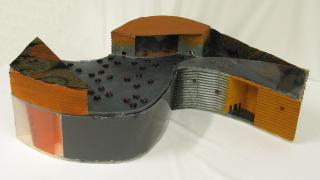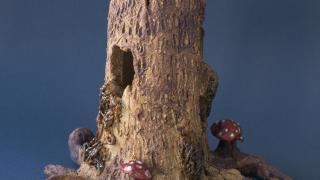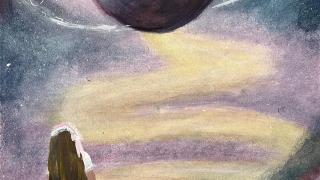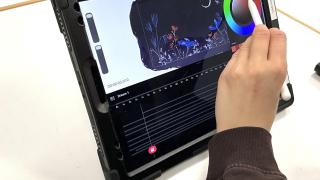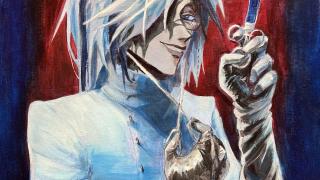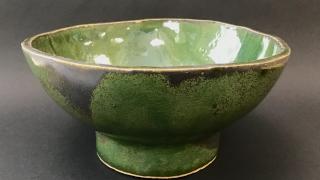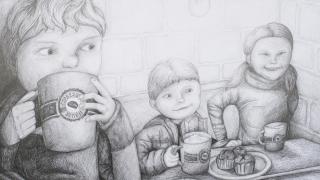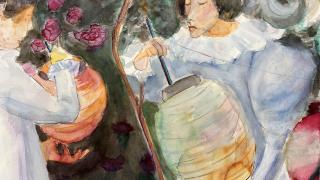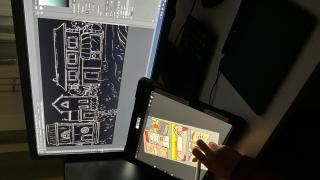Study Path
The basic studies in visual arts are divided into study modules according to age group. The studies involve the students progressing from one level to the next, developing their skills.

Picture: Vantaa Art School. Work of art: Kaisa Jäntti 18v.
Visual arts education
We provide a diverse look into the techniques, tools and history of visual art.
Students progress from level to level in accordance with the extensive syllabus of basic education in visual arts.
You will get the opportunity to give your thoughts, emotions, memories and observations visual form.
Among other activities, the lessons involve painting, drawing, modelling, photography, animation and building.
We discuss the subject matter of the works together and study various works.
We delve into art history as well as contemporary and media art.
We also organise some exhibition visits.
The annual lessons are divided across 34 weeks: 16 in the autumn term and 18 in the spring term. A more detailed yearly schedule is available on the page Information for students.
“Everyone is encouraged to create art, and the atmosphere is filled with creativity and joy. My child gets to try a variety of techniques and learn to draw well. There is no competition in the group, and no works are evaluated or criticised. Everyone is accepted as they are.”Art School’s survey to parents and guardians: What would be the art school of your dreams?
Kuvataidekoulun lukujärjestys 2025-2026(pdf, 135.27 KB)
Early studies for ages 5-7
Picture: Vantaa Art School.
Play and enjoyable experiences are at the core of the education. We approach the visual world through dialogue regarding children’s thoughts, experiences and observations.
We also focus on creating team spirit and relationships between students. We celebrate our own creations and those of others and learn to work in a group in a considerate manner.
We develop motor skills and persistence by studying techniques and trying out a variety of tools and learning how to maintain them.
The early art education aimed at children aged 5–7 is not included in the extensive visual art syllabus, but it builds a foundation for further studies.
We also provide education in Finnish one evening per week.
The duration of a lesson is 75 minutes.
The groups consist of 8–10 students from one or two age groups.
Admitted students can continue their studies from one school year to the next without separate registration. If a student wants to end the studies or take a gap year, the family must fill in a separate change notification form on the Eepos service.
“I’ve learned to handle clay carefully – I’ve learned to make green – I’ve learned to make purple – I’ve made a wonderful hedgehog – I’ve learned to clean up after myself – I’ve learned to make a colour circle – I’ve learned to wash my brush well – I’ve learned to draw with coal – I’ve learned to mix colours – I’ve learned to paint”Student's answer to the What have I learned at art school? survey for 5–7-year-olds.
Basic studies for ages 7-12
Picture: Vantaa Art School.
The education centres around deepening each student’s relationship with art and artistic expression.
We examine content stemming from students’ observations, experiences and lives.
We learn about art history and topical phenomena, including related social effects.
We study the impacts of the visual environment and how their significance is formed through a variety of environments, natural and built.
We practice the skills necessary to construct an image by learning about a variety of materials and techniques and their expressive possibilities. We also utilise digital and other technologies in the studies.
The diverse work develops each student’s visual thinking and problem-solving skills.
In addition, we organise a basic-level building and architecture group for 7–12-year-olds in Tikkurila.
It involves building with a variety of materials and learning about architecture.
We also provide education in Finnish one afternoon/evening per week.
The duration of a lesson is 90 or 135 minutes.
The groups consist of about 12 students from one or two age groups.
Admitted students can continue their studies from one school year to the next until the age of 12 without separate registration. If a student wants to end the studies or take a gap year, the family must fill in a separate change notification form on the Eepos service.
“We paint and get new friends. We draw and get new ideas.”12-year-old student in the ‘What would be the art school of your dreams?’ survey
Basic studies workshops for ages 13–14 and Advanced studies for ages 15–20
We encourage independent thinking and working as well as setting one’s own goals and assessing them.
The studies are divided into basic workshops for 13–14-year-olds and advanced workshops for 15–20-year-olds.
Visual Dance
Picture: Vantaa Art School.
The joint groups of Vantaa Dance Institute and Vantaa Art School are intended for children aged 5–10.
The visual dance education is a collaborative effort by Vantaa Dance Institute and Vantaa Art School, which has been running for more than 20 years.
The students are customers of Vantaa Dance Institute.
The lessons involve studying a single theme over the course of the term through creating movement and visual art.
We study visual art in a diverse manner by drawing, painting, modelling and photography.
In dance education, we delve into modern dance techniques in an age-appropriate manner; improvisation and creative expression play an important role.
Our art education is result-oriented and progresses from level to level.
More information and registration instructions are available on the Vantaa Dance Institute’s website.
We can also learn more about the visual dance studies by e-mailing marja.juutinen(at)vantaa.fi.
Final Project
Picture: Vantaa Art School. Work of art: Nap, acrylic, student Juliet Sivonen.
The final project is part of the advanced studies. It is an independent work designed and completed by a student during one year of studies. Each student gets to choose the subject and implementation method.
Requirements for the final project are 16 years of age and at least two years of workshop studies.
The final project consists of the following:
- An artistic work
- A portfolio, i.e. a written portion in which the students describe their work process in various ways and assess their output.
- Final project exhibition
To complete the final project, the student must:
- prepare a final project plan, which needs to be handed in to the final project coordinator by the set deadline.
- take part in the final project info events and read the handouts.
- collect documentation on the work process and assess the output.
- participate in the final project exhibition and its construction.
Through completing the final project, the students gain a better grasp of project management as well as goals and reaching them.
In the final project works, the students display their unique study paths and conceptions of art. They also demonstrate their ability to apply any knowledge and skills learned.
The assessment of the final project is based on each student’s own goals and the objectives specified in the curriculum.
We provide the students with a written assessment.
Students do not need to end their studies with the final project. They can continue studying until the age of 20.
It is a good idea to complete the final project, if you would like a certificate for your studies. The certificate also includes a written assessment of the extensive syllabus completed in the field of visual art.
More information on the final project is available from your teacher and final project coordinator.
Assessment
Picture: Vantaa Art School. Work of art: Wanderer, Jeroen Affolter 17 years old.
We assess students during their studies and once they have completed the extensive studies and advanced studies.
Our teachers assess students during each lesson. What this means in practice is providing feedback to support learning and steering the work. The lessons can involve personal feedback or joint feedback discussion.
The written assessment focuses on the strengths of each student’s learning and competence.
At the end of the basic studies and advanced studies, we provide the students with certificates. They include an assessment of each student’s progress and the development of their skills over the course of the studies.
“Yes, I think so. In addition to the personal feedback, I think it’s beneficial to examine other students’ works and discuss them with the group. This way, the children learn to derive pleasure from the achievements of others and share good ideas. The most important thing is to not compete about who draws the best or the right way and, instead, take all kinds of views into account.”
Response in the parents’ survey ‘Is the feedback and development assessment to the children sufficient?’
“I want the feedback I get to be constructive and not too pandering. There could be more feedback but preferably from the teachers only, since it’s more difficult for students to assess their peers.”
15–17-year-old student in the survey ‘Do you need more feedback on your work?’
Now that you have learned about the structure of our studies, you must be interested on how to become a student. You can find out more here.
If you have further questions about what students do at our school, you can also view our image gallery.
If regular studies do not feel like something you would like to do, you can quench your thirst for making art by attending our short courses.



